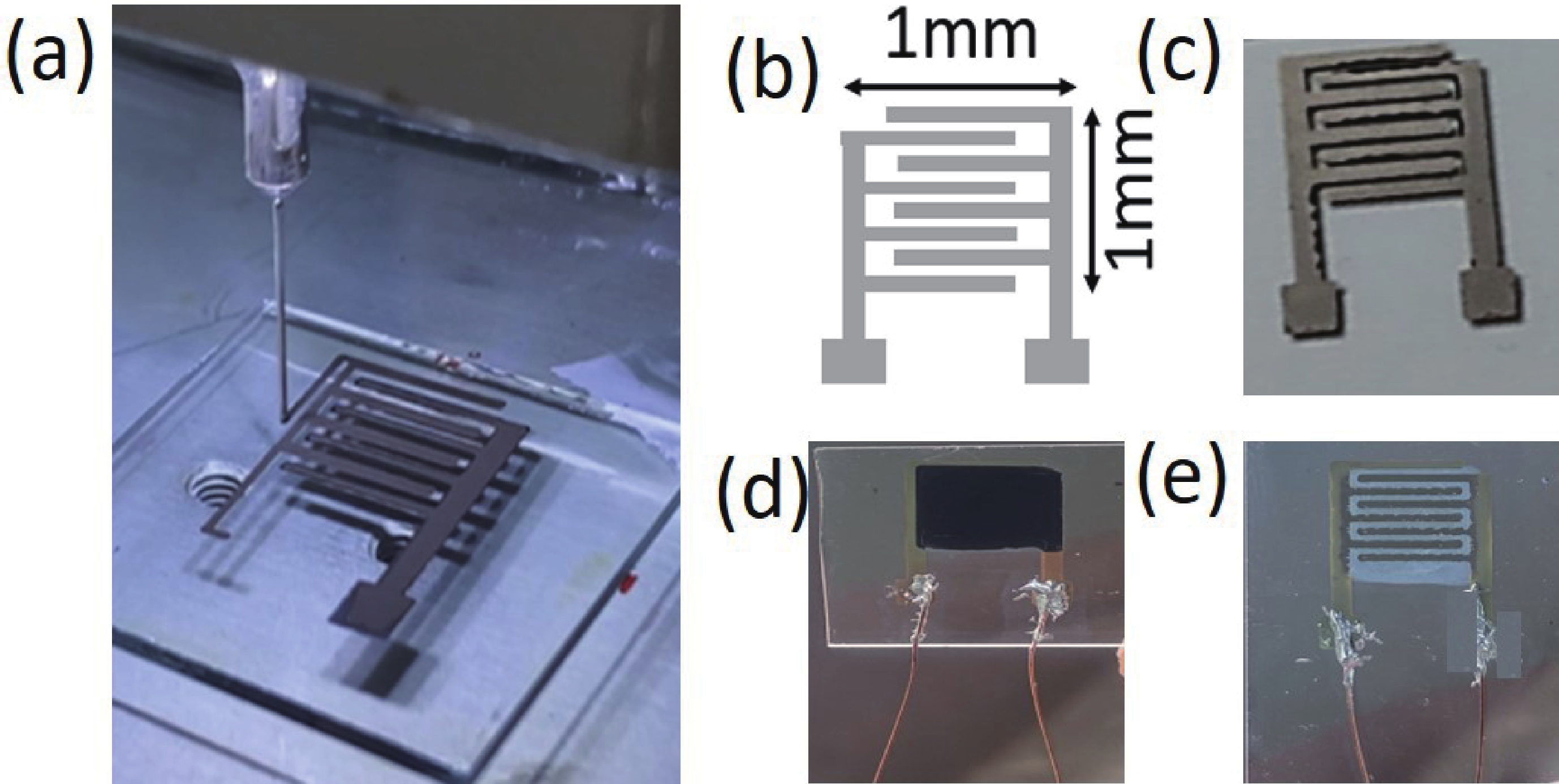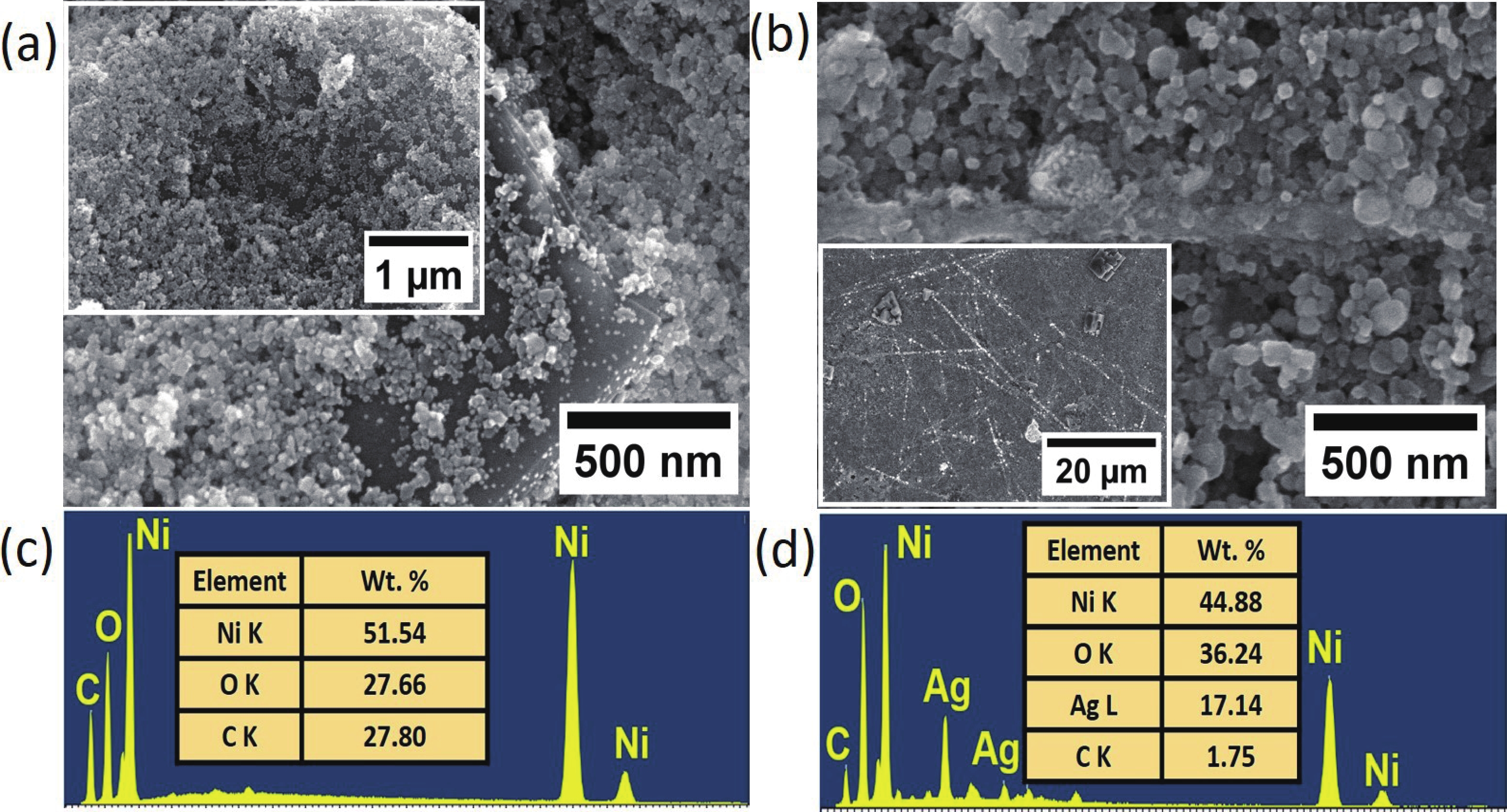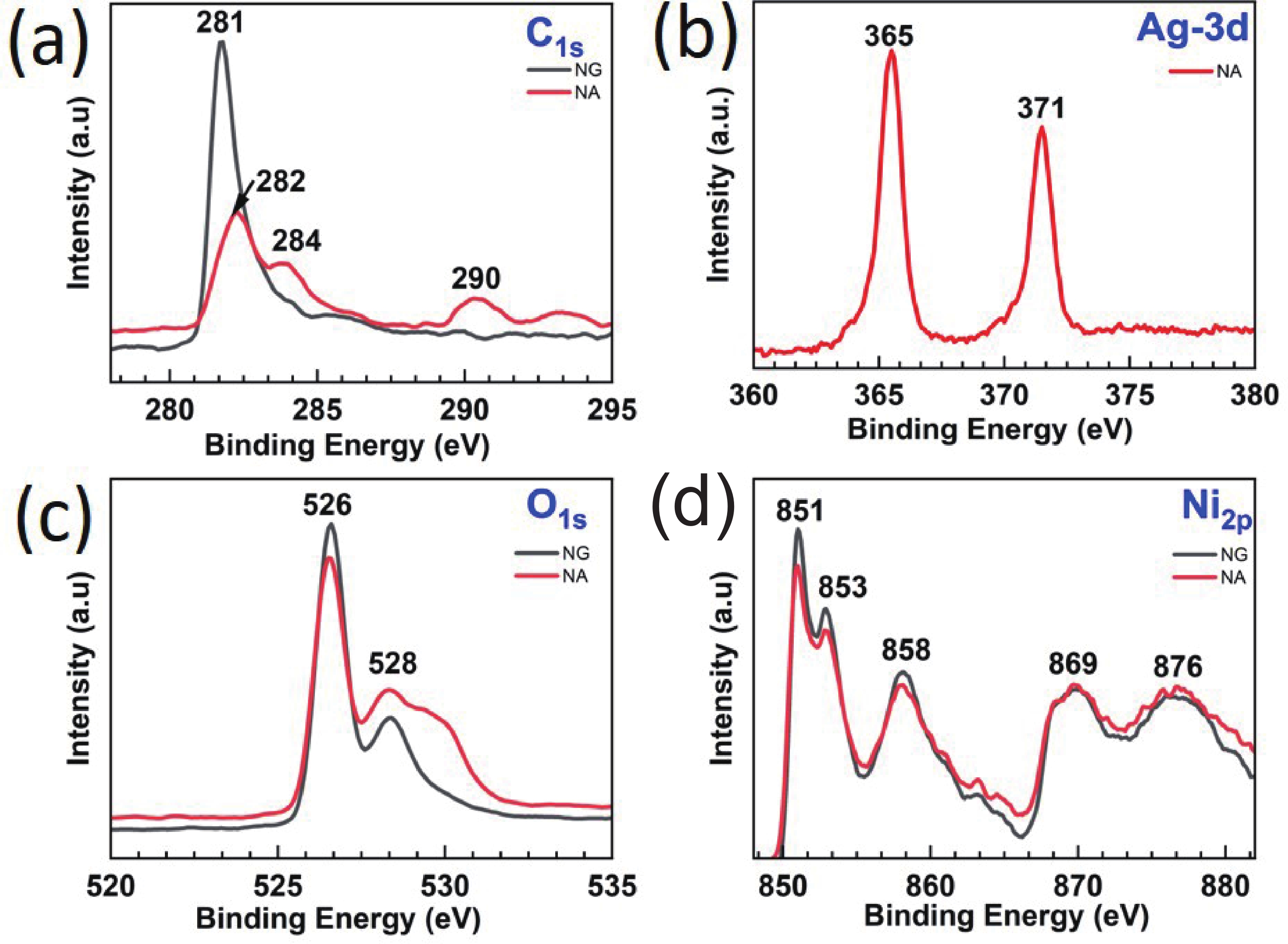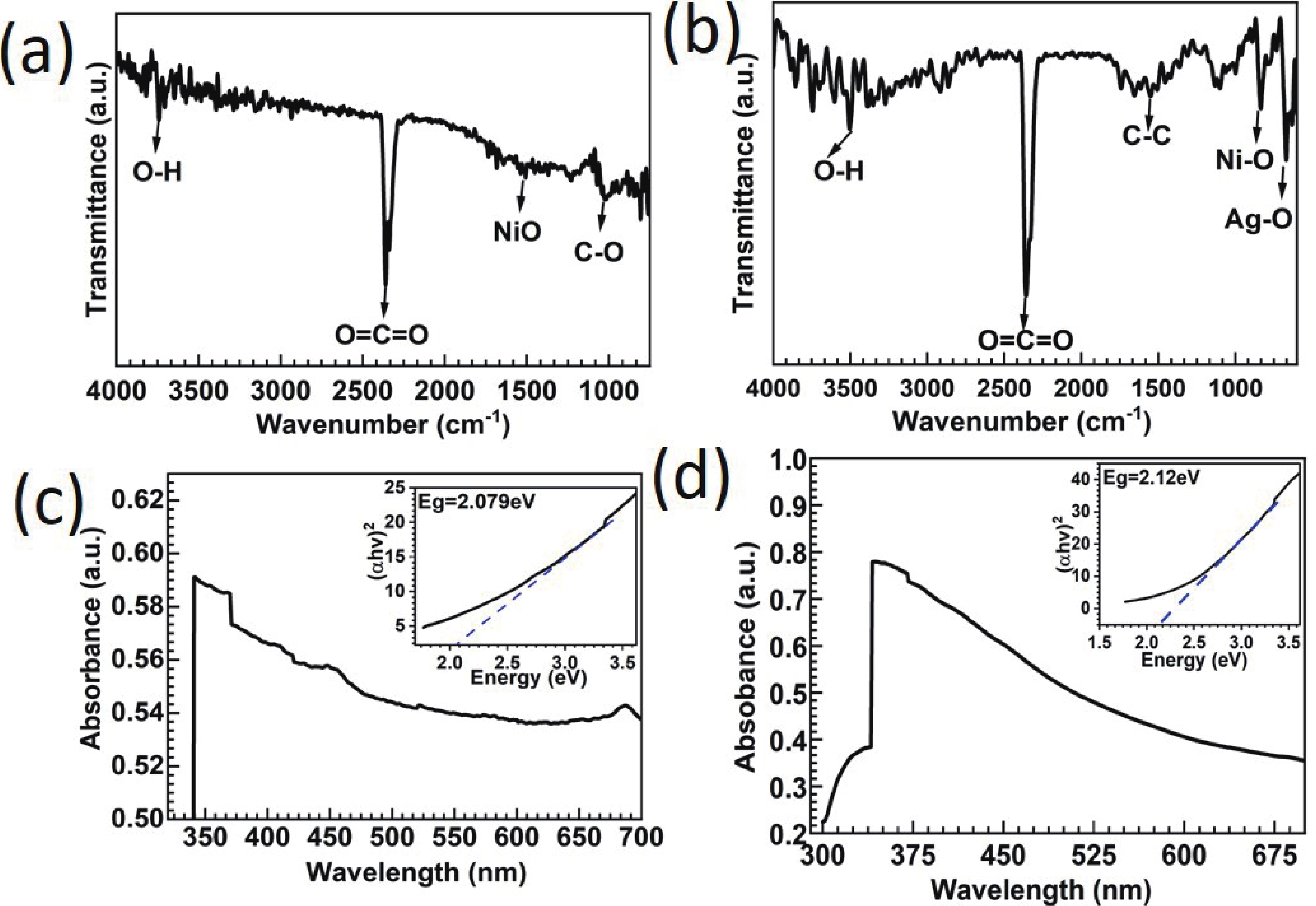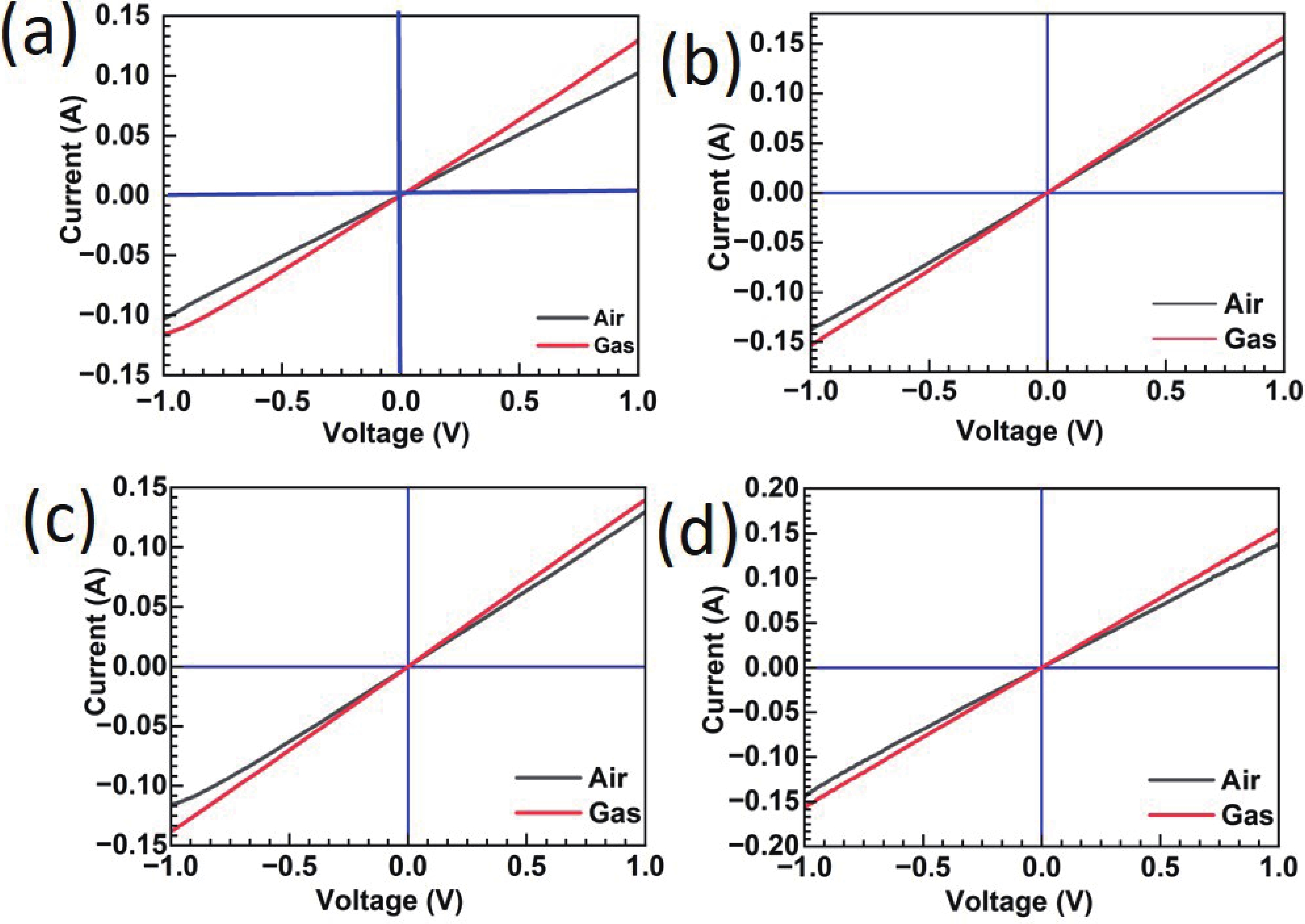| Citation: |
Neha Thakur, Hari Murthy, Sudha Arumugam, Neethu Thomas, Aarju Mathew Koshy, Parasuraman Swaminathan. Direct ink writing of nickel oxide-based thin films for room temperature gas detection[J]. Journal of Semiconductors, 2025, 46(1): 012606. doi: 10.1088/1674-4926/24080025
****
N Thakur, H Murthy, S Arumugam, N Thomas, A M Koshy, and P Swaminathan, Direct ink writing of nickel oxide-based thin films for room temperature gas detection[J]. J. Semicond., 2025, 46(1), 012606 doi: 10.1088/1674-4926/24080025
|
Direct ink writing of nickel oxide-based thin films for room temperature gas detection
DOI: 10.1088/1674-4926/24080025
CSTR: 32376.14.1674-4926.24080025
More Information-
Abstract
The rapid industrial growth and increasing population have led to significant pollution and deterioration of the natural atmospheric environment. Major atmospheric pollutants include NO2 and CO2. Hence, it is imperative to develop NO2 and CO2 sensors for ambient conditions, that can be used in indoor air quality monitoring, breath analysis, food spoilage detection, etc. In the present study, two thin film nanocomposite (nickel oxide-graphene and nickel oxide-silver nanowires) gas sensors are fabricated using direct ink writing. The nano-composites are investigated for their structural, optical, and electrical properties. Later the nano-composite is deposited on the interdigitated electrode (IDE) pattern to form NO2 and CO2 sensors. The deposited films are then exposed to NO2 and CO2 gases separately and their response and recovery times are determined using a custom-built gas sensing setup. Nickel oxide-graphene provides a good response time and recovery time of 10 and 9 s, respectively for NO2, due to the higher electron affinity of graphene towards NO2. Nickel oxide-silver nanowire nano-composite is suited for CO2 gas because silver is an excellent electrocatalyst for CO2 by giving response and recovery times of 11 s each. This is the first report showcasing NiO nano-composites for NO2 and CO2 sensing at room temperature.-
Keywords:
- nickel oxide,
- graphene,
- silver nanowires,
- NO2,
- CO2,
- gas sensor
-
References
[1] D Richter, Caillol S. Fighting global warming: The potential of photocatalysis against CO2, CH4, N2O, CFCs, tropospheric O3, BC and other major contributors to climate change. J Photochem Photobiol C: Photochem Rev, 2011, 12, 1 doi: 10.1016/j.jphotochemrev.2011.05.002[2] Saxena P, Shukla P. A review on recent developments and advances in environmental gas sensors to monitor toxic gas pollutants. Environ Prog Sustain Energy, 2023, 42, e14126 doi: 10.1002/ep.14126[3] Wetchakun K, Samerjai T, Tamaekong N, et al. Semiconducting metal oxides as sensors for environmentally hazardous gases. Sens Actuat B Chem, 2011, 160, 580 doi: 10.1016/j.snb.2011.08.032[4] Shaik M, Rao V, Gupta M, et al. Chemiresistive gas sensor for the sensitive detection of nitrogen dioxide based on nitrogen doped graphene nanosheets. RSC Adv, 2016, 6, 1527 doi: 10.1039/C5RA21184K[5] Arroyo P, Gómez-Suárez J, Herrero A, et al. Electrochemical gas sensing module combined with unmanned aerial vehicles for air quality monitoring. Sens Actuat B: Chem, 2021, 364, 131815 doi: 10.1016/j.snb.2022.131815[6] Ishihara T, Matsubara S. Capacitive type gas sensors. J electceram 2, 1998, 215 doi: 10.1023/A:1009970405804[7] Wang T, Huang D, Yang Z, et al. A review on graphene-based gas/vapor sensors with unique properties and potential applications. Nano Micro Lett, 2016, 8, 95 doi: 10.1007/s40820-015-0073-1[8] Gomaa M, Sayed M, Patil V, et al. Gas sensing performance of sprayed NiO thin films toward NO2 gas. J Alloys Compd, 2021, 885, 160908 doi: 10.1016/j.jallcom.2021.160908[9] Miura N, Wang J, Nakatou M, et al. High-temperature operating characteristics of mixed-potential-type NO2 sensor based on stabilized-zirconia tube and NiO sensing electrode. Sens Actuat B Chem, 2006, 114, 903 doi: 10.1016/j.snb.2005.08.009[10] Ko G, Kim H Y, Ahn J, et al. Graphene-based nitrogen dioxide gas sensors. Curr Appl Phys, 2010, 10, 1002 doi: 10.1016/j.cap.2009.12.024[11] Zhang J, Liu X, Neri G, et al. Nanostructured materials for room-temperature gas sensors. Adv Mater, 2016, 28, 795 doi: 10.1002/adma.201503825[12] Azad A, Akbar S A, Mhaisalkar S, et al. Solid-state gas sensors: A review. J Electrochem Soc, 1992, 139, 3690 doi: 10.1149/1.2069145[13] Hoa L T, Tien H N, Hur S H. Fabrication of novel 2D NiO nanosheet branched on 1D-ZnO nanorod arrays for gas sensor application. J Nanomater, 2014, 2014, 710874 doi: 10.1155/2014/710874[14] Molina A, Escobar-Barrios V, Oliva J. A review on hybrid and flexible CO2 gas sensors. Synth Met, 2020, 270, 116602 doi: 10.1016/j.synthmet.2020.116602[15] Maity A, Raychaudhuri A, Ghosh B. High sensitivity NH3 gas sensor with electrical readout made on paper with perovskite halide as sensor material. Sci Rep, 2019, 9, 7777 doi: 10.1038/s41598-019-43961-6[16] Xuan J, Zhao G, Sun M, et al. Low-temperature operating ZnO-based NO2 sensors: A review. RSC Adv, 2020, 10, 39786 doi: 10.1039/D0RA07328H[17] Bai H, Guo H, Wang J, et al. A room-temperature NO2 gas sensor based on CuO nanoflakes modified with rGO nanosheets. Sens Actuat B Chem, 2021, 337, 129783 doi: 10.1016/j.snb.2021.129783[18] Kumar R, Mamta Kumari R, Singh V N. SnO2-based NO2 gas sensor with outstanding sensing performance at room temperature. Micromachines, 2023, 14, 728 doi: 10.3390/mi14040728[19] Shendage S, Patil V, Vanalakar S, et al. Sensitive and selective NO2 gas sensor based on WO3 nanoplates. Sens Actuat B Chem, 2017, 240, 426 doi: 10.1016/j.snb.2016.08.177[20] Wang C, Chang X, Liu X, et al. ZnIn2S4 nanosheets for efficient NO2 detection at room temperature: Insights into the role of sulfur vacancies. J Phys Chem Lett, 2024, 15, 5875 doi: 10.1021/acs.jpclett.4c00919[21] Liu W, Gu D, Li X. AuPt bimetal-functionalized SnSe2 micro flower-based sensors for detecting sub-ppm NO2 at low temperatures. ACS Appl Mater Interfaces, 2021, 13, 20336 doi: 10.1021/acsami.1c02500[22] Li X, Chang X, Liu X, et al. High-entropy oxide (FeCoNiCrMn)3O4 for room-temperature NO2 sensors. Appl Phys Lett, 2024, 124, 22 doi: 10.1063/5.0191206[23] Zhao K, Chang X, Zhang J, et al. Electronic modulation of MoS2 nanosheets by N-doping for highly sensitive NO2 detection at room temperature. ACS Sens, 2023, 9, 388 doi: 10.1021/acssensors.3c02148[24] Kim Y, Kwon K C, Kang S, et al. Two-dimensional NbS2 gas sensors for selective and reversible NO2 detection at room temperature. ACS Sens, 2019, 4, 2395 doi: 10.1021/acssensors.9b00992[25] Lin L, Feng Z, Dong Z, et al. Transition metal disulfide (MoTe2, MoSe2 and MoS2) were modified to improve NO2 gas sensitivity sensing. J Ind Eng Chem, 2023, 118, 533 doi: 10.1016/j.jiec.2022.11.036[26] Manzoor S, Talib M, Novikov S M, et al. Physisorption-mediated charge transfer in TiS2 nanodiscs: A room temperature sensor for highly sensitive and reversible carbon dioxide detection. ACS Sens, 2023, 8, 3435 doi: 10.1021/acssensors.3c00931[27] Beniwal A, Ganguly P, Gond R, et al. Room temperature operated PEDOT: PSS based flexible and disposable NO2 gas sensor. IEEE Sens Lett, 2023, 7, 2001804 doi: 10.1109/LSENS.2023.3308518[28] Shinde P V, Shinde N M, Shaikh S F, et al. Room-temperature synthesis and CO2-gas sensitivity of bismuth oxide nanosensors. RSC Adv, 2020, 10, 17217 doi: 10.1039/D0RA00801J[29] Cai Z, Park J, Jun D, et al. High-performance UV-activated room temperature NO2 sensors based on TiO2/In2O3 composite. Cryst Eng Comm, 2023, 25, 2546 doi: 10.1039/D3CE00004D[30] Thakur N, Thomas N, Koshy A M, et al. Formulation of nickel oxide–graphene composite ink and the fabrication of thin-film electrodes using direct ink writing. J Electron Mater, 2024, 53, 2573 doi: 10.1007/s11664-024-10984-3[31] Yue Z, Niu W, Zhang W, et al. Detection of CO2 in solution with a Pt–NiO solid-state sensor. J Colloid Interface Sci, 2010, 348, 227 doi: 10.1016/j.jcis.2010.04.020[32] Raza M A, Habib A, Kanwal Z, et al. Optical CO2 gas sensing based on TiO2 thin films of diverse thickness decorated with silver nanoparticles. Adv Mater Sci Eng, 2018, 2780203 doi: 10.1155/2018/2780203[33] Thakur N, Murthy H. Nickel-based inks for inkjet printing: A review on latest trends. Amer J of Mater Sci, 2021, 11, 20 doi: 10.5923/j.materials.20211101.03[34] Thakur N, Swaminathan P, Murthy H. Mathematical model of nickel-graphene composite inks for jetting properties in inkjet printing. Malays J Sci, 2024, 43, 59 doi: 10.22452/mjs.vol43no3.8[35] Sharma S, Ganeshan S K, Pattnaik P K, et al. Laser induced flexible graphene electrodes for electrochemical sensing of hydrazine. Mater Lett, 2020, 262, 127150 doi: 10.1016/j.matlet.2019.127150[36] Shanavas S, Ahamad T, Alshehri S M, et al. A facile microwave route for fabrication of NiO/rGO hybrid sensor with efficient CO2 and acetone gas sensing performance using clad modified fiber optic method. Optik, 2021, 226, 165970 doi: 10.1016/j.ijleo.2020.165970[37] Walker J M, Akbar S A, Morris P A. Synergistic effects in gas sensing semiconducting oxide nano-heterostructures: A review. Sens Actuat B Chem, 2019, 286, 624 doi: 10.1016/j.snb.2019.01.049[38] Ngo Y L T, Hur S H. Low-temperature NO2 gas sensor fabricated with NiO and reduced graphene oxide hybrid structure. Mater Res Bull, 2016, 84, 168 doi: 10.1016/j.materresbull.2016.08.004[39] Jeong H Y, Lee D S, Choi H K, et al. Flexible room-temperature NO2 gas sensors based on carbon nanotubes/reduced graphene hybrid films. Appl Phys Lett, 2010, 96, 213105 doi: 10.1063/1.3432446[40] Zhang J, Zeng D, Zhao S, et al. Room temperature NO2 sensing: What advantage does the rGO–NiO nanocomposite have over pristine NiO? Phys Chem Chem Phys, 2015, 17, 14903 doi: 10.1039/C5CP01987G[41] Musayeva N, Hashimov A, Khalilova H, et al. Enhancement effect of Ni and NiO on gas sensing characteristics of carbon nanotube based structures. Fuller Nanotub Carbon Nanostruct, 2023, 31, 1115 doi: 10.1080/1536383X.2023.2246165[42] Mitri F, De Iacovo A, De Luca M, et al. Lead sulphide colloidal quantum dots for room temperature NO2 gas sensors. Sci Rep, 2020, 10, 12556 doi: 10.1038/s41598-020-69478-x[43] Umar A, Akbar S, Kumar R, et al. Ce-doped ZnO nanostructures: A promising platform for NO2 gas sensing. Chemosphere, 2024, 349, 140838 doi: 10.1016/j.chemosphere.2023.140838[44] Sharma N, Nair N M, Nagasarvari G, et al. A review of silver nanowire-based composites for flexible electronic applications. Flex Print Electron, 2022, 7, 014009 doi: 10.1088/2058-8585/ac5214[45] Sudha A, Mohammad M J, Solly M M, et al. Nickel tungstate derived from WO3 and NiO for room temperature CO2 sensing. App Phy A, 2024, 130, 1 doi: 10.1007/s00339-023-07241-5[46] Saadi M A, Maguire A, Pottackal N T, et al. Direct ink writing: A 3D printing technology for diverse materials. Adv Mater, 2022, 34, 2108855 doi: 10.1002/adma.202108855[47] Hon K, Li L, Hutchings I. Direct writing technology—Advances and developments. CIRP Ann, 2008, 57, 601 doi: 10.1016/j.cirp.2008.09.006[48] Fang Y, Akbari M, Hester J G, et al. Sensitivity enhancement of flexible gas sensors via conversion of inkjet-printed silver electrodes into porous gold counterparts. Sci Rep, 2017, 7, 8988 doi: 10.1038/s41598-017-09174-5[49] Chen W, Zhou Q, Wan F, et al. Gas sensing properties and mechanism of nano-SnO2-based sensor for hydrogen and carbon monoxide. J Nanomater, 2012, 1 doi: 10.1155/2012/612420[50] Thomas N, Sharma N, Swaminathan P. Optimizing silver nanowire dimensions by the modification of polyol synthesis for the fabrication of transparent conducting films. Nanotechnology, 2024, 35, 055602 doi: 10.1088/1361-6528/ad07a1[51] Qiao H, Wei Z, Yang H, et al. Preparation and characterization of NiO nanoparticles by anodic arc plasma method. J Nanomater, 2009, 1 doi: 10.1155/2009/795928[52] El-Kemary M, Nagy N, El-Mehasseb I. Nickel oxide nanoparticles: Synthesis and spectral studies of interactions with glucose. Mater Sci Semicond Process, 2013, 16, 1747 doi: 10.1016/j.mssp.2013.05.018[53] Muhammed Shajudheen V, Sivakumar M, Saravana Kumar S. Synthesis and characterization of NiO nanoparticles by thermal oxidation of nickel sulfide nanoparticles. Mater Today Proc, 2016, 3, 2450 doi: 10.1016/j.matpr.2016.04.161[54] Muniz F T L, Miranda M A R, Morilla dos Santos C, et al. The Scherrer equation and the dynamical theory of X-ray diffraction. Acta Crystallogr A Found Adv, 2016, 72, 385 doi: 10.1107/S205327331600365X[55] Mozaffari N, Mozaffari N, Elahi S M, et al. Kinetics study of CO molecules adsorption on Al2O3/Zeolite composite films prepared by roll-coating method. Surf Eng, 2021, 37, 390 doi: 10.1080/02670844.2020.1768628[56] Thakur N, Murthy H. Simulation study of droplet formation in inkjet printing using ANSYS FLUENT. J Phys: Conf Ser, 2022, 2161, 012026 doi: 10.1088/1742-6596/2161/1/012026[57] Kang S B, Jo Y, Lam N H, et al. Nitrogen-doped nickel graphene core shell synthesis: Structural, morphological, and chemical composition for planar hybrid solar cells application. Photonics, 2022, 10, 18 doi: 10.3390/photonics10010018[58] Bari B, Lee J, Jang T, et al. Simple hydrothermal synthesis of very-long and thin silver nanowires and their application in high quality transparent electrodes. J Mater Chem A, 2016, 4, 11365 doi: 10.1039/C6TA03308C[59] Yang W, Li J, Zhong Y, et al. Facile Cl–-mediated hydrothermal synthesis of large-scale Ag nanowires from AgCl hydrosol. Cryst Eng Comm, 2013, 15, 2598 doi: 10.1039/c3ce26925f[60] Wu S, Hui K, Hui K N, et al. Silver particle-loaded nickel oxide nanosheet arrays on nickel foam as advanced binder-free electrodes for aqueous asymmetric supercapacitors. RSC Adv, 2017, 7, 41771 doi: 10.1039/C7RA06252D[61] Hossain M. M. Metal oxide semiconductor/graphene heterojunction-based sensors. PhD Dissertation, Clemson University, 2017[62] Chu L, Li M, Wang Y, et al. Multishelled NiO hollow spheres decorated by graphene nanosheets as anodes for lithium-ion batteries with improved reversible capacity and cycling stability. J Nanomater, 2016, 4901847 doi: 10.1155/2016/4901847[63] Visweswaran S, Venkatachalapathy R, Haris M, et al. Structural, morphological, optical and magnetic properties of sprayed NiO thin films by perfume atomizer. Appl Phys A, 2020, 126, 524 doi: 10.1007/s00339-020-03709-w[64] Verma R, Chauhan M S, Pandey S, et al. Reduced graphene Oxide/NiO based nano-composites for the efficient removal of alizarin dye, indigo dye and reduction of nitro aromatic compounds. Heliyon, 2023, 9, e17162 doi: 10.1016/j.heliyon.2023.e17162[65] Joshi N, Jain N, Pathak A, et al. Biosynthesis of silver nanoparticles using Carissa carandas berries and its potential antibacterial activities. J Sol Gel Sci Technol, 2018, 86, 682 doi: 10.1007/s10971-018-4666-2[66] Chen X, Zhao A, Gao Q, et al. Fabrication of silver nanowires with corrugated-surface and its SERS performance. Acta Chim Sinica, 2014, 72, 467 doi: 10.6023/A13121211[67] Nagamuthu S, Ryu K S. Synthesis of Ag/NiO honeycomb structured nanoarrays as the electrode material for high performance asymmetric supercapacitor devices. Sci Rep, 2019, 9, 4864 doi: 10.1038/s41598-019-41446-0[68] Prieto P, Nistor V, Nouneh K, et al. XPS study of silver, nickel and bimetallic silver–nickel nanoparticles prepared by seed-mediated growth. Appl Surf Sci, 2012, 258, 8807 doi: 10.1016/j.apsusc.2012.05.095[69] Al-Nafiey A, Kumar A, Kumar M, et al. Nickel oxide nanoparticles grafted on reduced graphene oxide (rGO/NiO) as efficient photocatalyst for reduction of nitroaromatics under visible light irradiation. J Photochem Photobiol A Chem, 2017, 336, 198 doi: 10.1016/j.jphotochem.2016.12.023[70] Chen X, Wang X, Fang D. A review on C1s XPS-spectra for some kinds of carbon materials. Fuller Nanotub Carbon Nanostruct, 2020, 28, 1048 doi: 10.1080/1536383X.2020.1794851[71] Sankar A, Chitra S V, Jayashree M, et al. NiO nanoparticles/graphene nanocomposite as high-performance pseudocapacitor electrodes: Design and implementation. Diam Relat Mater, 2022, 122, 108804 doi: 10.1016/j.diamond.2021.108804[72] Kottegoda I R, Idris N H, Lu L, et al. Synthesis and characterization of graphene–nickel oxide nanostructures for fast charge–discharge application. Electrochem Acta, 2011, 56, 5815 doi: 10.1016/j.electacta.2011.03.143[73] Saravanakkumar D, Karthika R, Ganasaravanan S, et al. Synthesis of NiO doped ZnO/MWCNT nanocomposite and its characterization for photocatalytic & antimicrobial applications. J Appl Phys, 2018, 10, 73 doi: 10.9790/486[74] Archana S, Jayanna B, Ananda A, et al. Synthesis of nickel oxide grafted graphene oxide nanocomposites—A systematic research on chemisorption of heavy metal ions and its antibacterial activity. Environ Nanotechnol Monit Manag, 2021, 16, 100486 doi: 10.1016/j.enmm.2021.100486[75] Saranya P, Selladurai S. Facile synthesis of NiSnO3/graphene nanocomposite for high-performance electrode towards asymmetric supercapacitor device. J Mater Sci, 2018, 53, 16022 doi: 10.1007/s10853-018-2742-1[76] Yousaf Z, Sajjad S, Khan A, et al. Interfacial charge transfer via 2D-NiO and 2D-graphene nanosheets combination for significant visible photocatalysis. J Solid State Chem, 2020, 291, 121606 doi: 10.1016/j.jssc.2020.121606[77] Santos R K, Martins T A, Silva G N, et al. Ag3PO4/NiO composites with enhanced photocatalytic activity under visible light. ACS Omega, 2020, 5, 21651 doi: 10.1021/acsomega.0c02456[78] Patil M, Ganbavle V, Rajpure K, et al. Fast response and highly selective nitrogen dioxide gas sensor based on Zinc Stannate thin films. Mater Sci Energy Technol, 2020, 3, 36 doi: 10.1016/j.mset.2019.11.002[79] Karsthof R, Wenckstern H, Zúñiga-Pérez J, et al. Nickel oxide–based heterostructures with large band offsets. Phys Status Solidi B, 2020, 257, 1900639 doi: 10.1002/pssb.201900639[80] Meng F J, Xin R F, Li S X. Metal oxide heterostructures for improving gas sensing properties: A review. Materials, 2022, 16, 263 doi: 10.3390/ma16010263[81] Schedin F, Geim A K, Morozov S V, et al. Detection of individual gas molecules adsorbed on graphene. Nature Mater, 2007, 6, 652 doi: 10.1038/nmat1967[82] Zhou Z, Gao H, Liu R, et al. Study on the structure and property for the NO2+NO2– electron transfer system. J Mol Struct Theochem, 2001, 545, 179 doi: 10.1016/S0166-1280(01)00416-X[83] Yoshioka Y, Schaefer H III, Jordan K. Theoretical investigation of the electron affinity of CO2. J Chem Phys, 1981, 75, 1040 doi: 10.1063/1.442071[84] Zhu X, Huang J, Eikerling M. Electrochemical CO2 reduction at silver from a local perspective. ACS Catal, 2021, 11, 14521 doi: 10.1021/acscatal.1c04791[85] Sassenburg M, Rooij R, Nesbitt N T, et al. Characterizing CO2 reduction catalysts on gas diffusion electrodes: Comparing activity, selectivity, and stability of transition metal catalysts. ACS Appl Energy Mater, 2022, 5, 5983 doi: 10.1021/acsaem.2c00160[86] Horta I M, Godoy A Jr, Damasceno B S, et al. Development of metal oxide heterostructures for photovoltaic and solar cell applications. Metal Oxide-Based Heterostructures. Amsterdam: Elsevier, 2023, 359[87] Farragher A, Page F, Wheeler R. Electron affinities of the oxides of nitrogen. Discuss Faraday Soc, 1964, 37, 203 doi: 10.1039/df9643700203[88] Moumen A, Kumarage G C, Comini E. P-type metal oxide semiconductor thin films: Synthesis and chemical sensor applications. Sensors, 2022, 22, 1359 doi: 10.3390/s22041359[89] Patil S, Arumugam S, Swaminathan P. Bismuth ferrite-silver nanowire flexible nanocomposites for room-temperature nitrogen dioxide sensing. ACS Omega, 2024, 9, 28978 doi: 10.1021/acsomega.4c04076[90] Varghese S S, Lonkar S, Singh K, et al. Recent advances in graphene based gas sensors. Sens Actuat B Chem, 2015, 218, 160 doi: 10.1016/j.snb.2015.04.062[91] Irwin M D, Buchholz D B, Hains A W, et al. p-Type semiconducting nickel oxide as an efficiency-enhancing anode interfacial layer in polymer bulk-heterojunction solar cells. Proc Natl Acad Sci USA, 2008, 105, 2783 doi: 10.1073/pnas.0711990105[92] Romero H E, Shen N, Joshi P, et al. N-type behavior of graphene supported on Si/SiO2 substrates. ACS Nano, 2008, 2, 2037 doi: 10.1021/nn800354m[93] Qian H, Negri F, Wang C, et al. Fully conjugated tri(perylene bisimides): An approach to the construction of n-type graphene nanoribbons. J Am Chem Soc, 2008, 130, 17970 doi: 10.1021/ja807803j[94] Bult J B, Crisp R, Perkins C L, et al. Role of dopants in long-range charge carrier transport for p-type and n-type graphene transparent conducting thin films. ACS Nano, 2013, 7, 7251 doi: 10.1021/nn402673z[95] Azani M R, Hassanpour A, Torres T. Benefits, problems, and solutions of silver nanowire transparent conductive electrodes in indium tin oxide (ITO)-free flexible solar cells. Adv Energy Mater, 2020, 10, 2002536 doi: 10.1002/aenm.202002536[96] Mokoena T P, Swart H C, Motaung D E. A review on recent progress of p-type nickel oxide based gas sensors: Future perspectives. J Alloys Compd, 2019, 805, 267 doi: 10.1016/j.jallcom.2019.06.329 -
Supplements
 24080025Supporting_information.pdf
24080025Supporting_information.pdf

-
Proportional views





 Neha Thakur is a research scholar at CHRIST (Deemed to be University), Bengaluru, specializing in Printed Electronics technology. She completed her Master’s degree from Centre for Development of Advanced Computing (CDAC) Noida in VLSI Design. Neha has participated in numerous national and international conferences and has published many research papers. Her recent publications include "Mathematical Model of Nickel-Graphene Composite Inks for Jetting Properties in Inkjet Printing" and "Formulation of Nickel Oxide-Graphene Composite Ink and the Fabrication of Thin-Film Electrodes Using Direct Ink Writing", among others. Her research focuses on nanoparticle synthesis, ink formulation, thin-film fabrication using direct ink writing, and gas sensors.
Neha Thakur is a research scholar at CHRIST (Deemed to be University), Bengaluru, specializing in Printed Electronics technology. She completed her Master’s degree from Centre for Development of Advanced Computing (CDAC) Noida in VLSI Design. Neha has participated in numerous national and international conferences and has published many research papers. Her recent publications include "Mathematical Model of Nickel-Graphene Composite Inks for Jetting Properties in Inkjet Printing" and "Formulation of Nickel Oxide-Graphene Composite Ink and the Fabrication of Thin-Film Electrodes Using Direct Ink Writing", among others. Her research focuses on nanoparticle synthesis, ink formulation, thin-film fabrication using direct ink writing, and gas sensors. Hari Murthy is currently an Assistant Professor in the Department of Electronics and Communication at CHRIST (Deemed to be University), Bengaluru. He earned his PhD from the University of Canterbury in 2017. Dr. Murthy has authored several journal articles and book chapters. His recent publications include "Internet of Things in Bioelectronics: Emerging Technologies and Applications" and "Mathematical Model of Nickel-Graphene Composite Inks for Jetting Properties in Inkjet Printing", among others.
Hari Murthy is currently an Assistant Professor in the Department of Electronics and Communication at CHRIST (Deemed to be University), Bengaluru. He earned his PhD from the University of Canterbury in 2017. Dr. Murthy has authored several journal articles and book chapters. His recent publications include "Internet of Things in Bioelectronics: Emerging Technologies and Applications" and "Mathematical Model of Nickel-Graphene Composite Inks for Jetting Properties in Inkjet Printing", among others. Sudha Arumugam is a postdoctoral fellow in the Electronic Materials and Thin Films Lab at the Indian Institute of Technology Madras. She received her PhD from the Indian Institute of Technology Kharagpur. Her research focuses on the development of metal oxide-based materials for flexible gas sensors and sustainable electrochromic displays.
Sudha Arumugam is a postdoctoral fellow in the Electronic Materials and Thin Films Lab at the Indian Institute of Technology Madras. She received her PhD from the Indian Institute of Technology Kharagpur. Her research focuses on the development of metal oxide-based materials for flexible gas sensors and sustainable electrochromic displays. Neethu Thomas works as a project scientist at the Indian Institute of Technology Madras' Department of Metallurgical and Materials Engineering (MME). She completed her Bachelor's and Master's degree from the Government Engineering Colleges in Calicut and Thrissur. She completed her PhD from IIT Madras. After that, she worked as a postdoctoral fellow at IIT Madras' Department of MME. Her work focuses on the synthesis, modeling, and self-assembly of noble metal nanostructures, formulating printable conducting inks for a variety of potential uses, including gas sensing, smart windows, electrochemical sensors, and transparent heaters. She has authored several publications in this area.
Neethu Thomas works as a project scientist at the Indian Institute of Technology Madras' Department of Metallurgical and Materials Engineering (MME). She completed her Bachelor's and Master's degree from the Government Engineering Colleges in Calicut and Thrissur. She completed her PhD from IIT Madras. After that, she worked as a postdoctoral fellow at IIT Madras' Department of MME. Her work focuses on the synthesis, modeling, and self-assembly of noble metal nanostructures, formulating printable conducting inks for a variety of potential uses, including gas sensing, smart windows, electrochemical sensors, and transparent heaters. She has authored several publications in this area. Aarju Mathew Koshy graduated from Amity University, Delhi, with an Integrated Master's degree in Nanotechnology. He completed his master’s thesis at the Institut für Technische Optik, University of Stuttgart, Germany. Aarju was a Research Assistant at MG University, Kerala before joining the Indian Institute of Technology Madras in 2020 as a Project Associate in the Electronic Materials and Thin Films Lab. Currently, Aarju is pursuing his doctoral degree at the University of Technology of Belfort-Montbéliard (UTBM), Belfort, France, continuing his research in advanced materials and printing technologies with an emphasis on 4D printing of smart materials with direct ink writing.
Aarju Mathew Koshy graduated from Amity University, Delhi, with an Integrated Master's degree in Nanotechnology. He completed his master’s thesis at the Institut für Technische Optik, University of Stuttgart, Germany. Aarju was a Research Assistant at MG University, Kerala before joining the Indian Institute of Technology Madras in 2020 as a Project Associate in the Electronic Materials and Thin Films Lab. Currently, Aarju is pursuing his doctoral degree at the University of Technology of Belfort-Montbéliard (UTBM), Belfort, France, continuing his research in advanced materials and printing technologies with an emphasis on 4D printing of smart materials with direct ink writing. Parasuraman Swaminathan graduated from Indian Institute of Technology (IIT) Madras, with a Bachelors and Master’s degree in Metallurgical and Materials Engineering. He completed his PhD from the University of Illinois at Urbana Champaign. He then worked as a postdoctoral fellow in Johns Hopkins University and the National Institute of Standards and Technology (NIST) before joining Intel Corp as a Module and Yield Integration Engineer. In 2013, he joined IIT Madras and is currently Head of the Electronic Materials and Thin Films Lab. His group works on printed electronics with a focus on flexible and transparent devices.
Parasuraman Swaminathan graduated from Indian Institute of Technology (IIT) Madras, with a Bachelors and Master’s degree in Metallurgical and Materials Engineering. He completed his PhD from the University of Illinois at Urbana Champaign. He then worked as a postdoctoral fellow in Johns Hopkins University and the National Institute of Standards and Technology (NIST) before joining Intel Corp as a Module and Yield Integration Engineer. In 2013, he joined IIT Madras and is currently Head of the Electronic Materials and Thin Films Lab. His group works on printed electronics with a focus on flexible and transparent devices.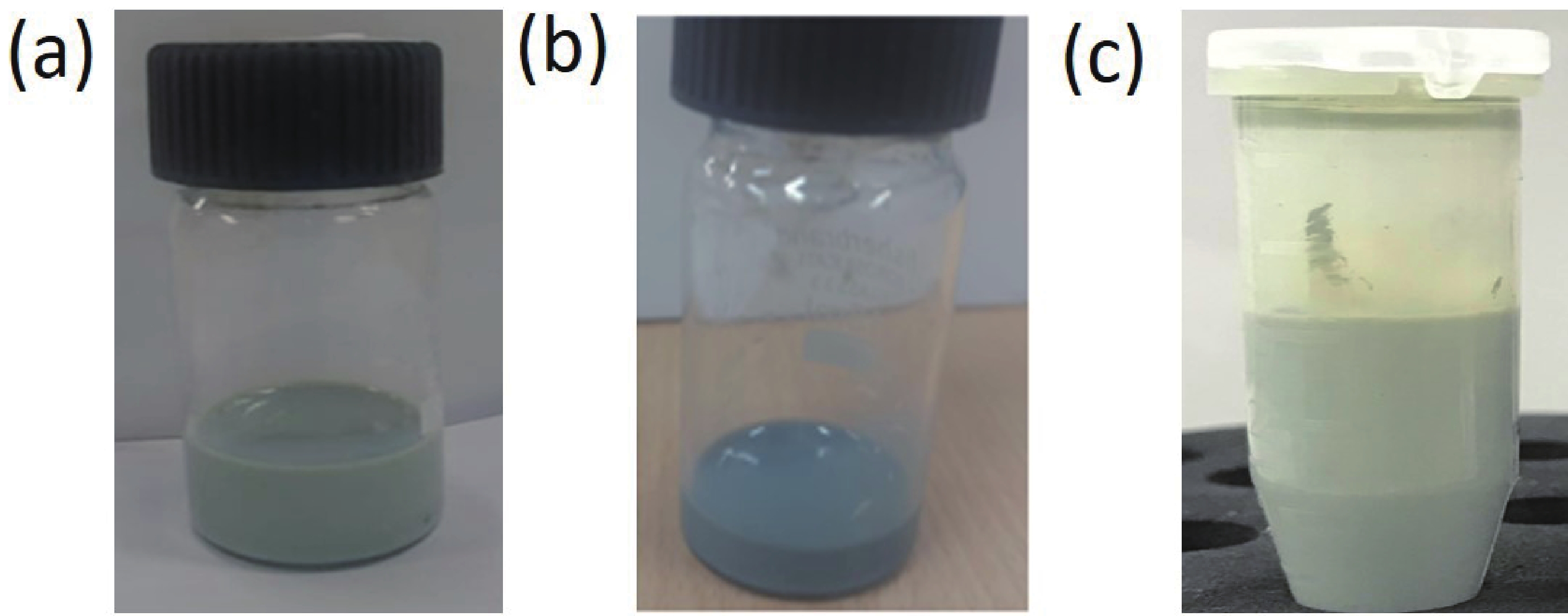
 DownLoad:
DownLoad:
